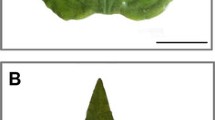Summary
As the CO2 supply often limits photosynthesis a number of aquatic species use HCO −3 as carbon source as well. The use of HCO −3 leads to the production of one OH− for every molecule/CO2 fixed. The OH− is excreted into the medium. We studied the mechanism of HCO −3 utilization in the leaves ofElodea andPotamogeton. In the so-called polar leaves of these plants the HCO −3 uptake takes place at the lower and OH−-release at the upper epidermis. This flux of negative charge is balanced by a kation flux in the same direction. The use of HCO −3 and the influx of kations is accompanied by a pH drop. The release of OH− and kations at the upper epidermis causes a raise of the pH there. The pH changes and the kation concentrations (in the present experiments K+) are measured by means of miniature electrodes. From this the CO2 (including H2CO3), HCO −3 and CO =3 concentrations were calculated. When the light is turned on, after a dark period, the pH increases simultaneously at both sides for 5–10 minutes. During this so-called a-polar phase there is no K+ transport through the leaf. Experiments at different ambient pH's and comparison with other aquatic species shows that this initial pH raise results from CO2 fixation. After 5–10 minutes the polar phase and HCO −3 utilization start. At the lower side the pH and [K+] drop, at the upper side pH and [K+] increase. During the a-polar phase [CO2] at the lower epidermis decreased, as expected. Whereas in the a-polar phase the CO2 concentration at this side very markedly increased. This sharp increase of [CO2] may be explained either by CO2 diffusion from the leaf cells previously taken up as HCO −3 or by a proton (H+) extrusion at the lower epidermis causing conversion of HCO −3 into CO2 in the cell wall. This latter mechanism is discussed in more detail.
Similar content being viewed by others
References
BUCH, K., 1960. Dissoziation der Kohlensäure, Gleichgewichte und Puffersysteme. In: Encyclopedia Plant Physiol., V:1–11.
FALK, F.H. and P. SITTE, 1963. Zellfeinbau bei Plasmolyse. I. Der Feinbau derElodea Blattzellen. Protoplasma, 57:290–303.
HELDER, R.J., 1975a. Polar potassium transport and electrical potential difference across the leaf ofPotamogeton lucens L. Proc. Kon. Ned. Akad. Wet., C, 78:189–197.
HELDER, R.J., 1975b. Flux ratios and concentration ratios in relation to electrical potential differences and transport of rubidium ions across the leaf ofPotamogeton lucens L. Proc. Kon. Ned. Akad. Wet., C, 78:376–388.
HELDER, R.J. and J. BOERMA, 1973. Exchange and polar transport of rubidium ions across the leaves ofPotamogeton. Acta Bot. Neerl. 22:686–693.
HELDER, R.J., and P.E. ZANSTRA, 1977. Changes of the pH at the upper and lower surface of bicarbonate assimilating leaves ofPotamogeton lucens L. Proc. Kon. Ned. Akad. Wet., C, 80:421–436.
LUCAS, W.J., 1975. The influence of light intensity on the activation and operation of the hydroxyl efflux system ofChara corallina. J. Exp. Bot., 26:347–360.
LUCAS, W.J. and F.A. SMITH, 1973. The formation of alkaline and acid regions at the surface ofChara corallina cells. J. Exp. Bot., 24:1–14.
LUCAS, W.J., M.T. TYREE, and A. PETROV, 1978. Characterization of photosynthetic14Carbon assimilation byPotamogeton lucens L. J. Exp. Bot., 29:1409–1421.
PATE, J.S. and B.E.S. GUNNING, 1972. Transfer cells. Ann. Rev. Plant Physiol., 23:173–196.
POOLE, R.J., 1978. Energy coupling for membrane transport. Ann. Rev. Plant Physiol., 29:437–461.
PRINS, H.B.A., 1980. Membrane potentials ofVallisneria leaf cells and their relation to photosynthesis. Plant Physiol. (in press).
PRINS, H.B.A. and R. WALSARIE WOLFF, 1974. Photorespiration in leaves ofVallisneria spiralis. The effect of oxygen on the carbon dioxide compensation point. Proc. Kon. Ned. Akad. Wet., C, 77:239–245.
STEEMANN NIELSEN, E., 1960. uptake of CO2 by the plant. In: Encyclopedia Plant Physiol., V:78–84.
Author information
Authors and Affiliations
Rights and permissions
About this article
Cite this article
Prins, H.B.A., Snel, J.F.H., Helder, R.J. et al. Photosynthetic bicarbonate utilization in the aquatic angiospermsPotamogeton andElodea . Hydrobiological Bulletin 13, 106–111 (1979). https://doi.org/10.1007/BF02284741
Published:
Issue Date:
DOI: https://doi.org/10.1007/BF02284741




